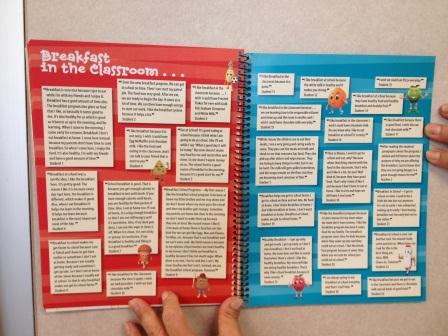Click here to read part one of our interview with Claudie, which focuses on her marketing and promotional efforts for breakfast-in-the-classroom.

Student & teacher testimonials are included in the breakfast-in-the-classroom promotional materials.
BB: Give us an overview of your program, and your marketing approach as a whole.
We have an extensive marketing program. We also empower our managers to get invested their programs, to take them on and treat them as their own business. Every year they have four major promotions they have to do; National School Lunch Week kicks it off. That’s where we disseminate information on our healthy lifestyle and wellness contest. The deadline to get those entries to us is the first of November, so we take that whole month to judge those entries, and we utilize our Industry Advisory Council to do the judging; we remove our staff from it so no favoritism is shown. We select first, second, and third place winners from each school and one grand prize winner for each level, district-wide.
We also have Fuel Up to Play 60, which is done at the school level because students and advisors [are in charge] on-site. We’ve had several schools enter that every year and they can win grant money through Fuel Up to Play 60. So schools who participate [in Fuel Up to Play 60] can count that as one of their promotions.
The next one we do is National School Breakfast Week. We ask students to use their creativity based on the national theme, or other themes we might come up with.
Each school is required to have a Youth Advisory Council (YAC); students meet four times a year and one of their activities is a t-shirt contest. The winning design t-shirt is made and distributed to the YACs, district-wide. We have a YAC summit every year, and those students meet with food manufacturers on our Industry Advisory Board to shadow them, or act as a focus group to give feedback on what they would like to see in the breakfast and lunch programs.
At the beginning of the school year our managers are given our strategic plan and a binder where they keep records for all of their promotions. They keep their marketing plan and report there, and then submit that binder in April of every year and our Industry Advisory Council reviews and judges the binders; the winning school is awarded as “The Recipe that Works.” They receive their award at our end-of-year celebration—our gala—thrown by our Industry Advisory Council.
BB: Tell us about some of the other programs and initiatives your nutrition department is running.
We conduct cooking classes with parents, which gives us the opportunity to talk with them about our program and the new dietary guidelines. We teach parents that these are things they can incorporate at home, give them information about how our foodservice program works, and they seem to enjoy that. We hold the classes in conjunction with our University of Illinois Extension service—our nutrition educator teaches a class and then a chef or I will demonstrate a recipe.
We also conduct a personal and professional development class for our staff; our managers and foodservice staff. We usually have from thirty-five to forty people register, and they have to come on their own time. We teach them life skills—how to interview, how to develop communication skills. We have some awesome graduates from those classes. Part of their class assignment is to think of an idea that they want to pitch or sell. They have to write up a business plan, tell us about their idea, and get someone to “buy-in” to their idea. One of our staff members wanted to do a hydroponic garden in the science classroom, showing the kids how to grow fruits and vegetables and they are doing it! Another one of our manager-chefs wanted to do a school garden program. He got involvement from the whole community; his Youth Advisory Council students built vegetable beds and grew vegetables for last year. He has now been designated the go-to person in the district for other schools who want to do vegetable gardens.
BB: Where does your funding come from for some of these initiatives?
For the cooking class, one of our food distributors—Gordon Foodservice–usually donates the food. Our Industry Advisory Council is great—they adopted our cafeteria, and help provide resources and time to support our intiatives. We are very excited about our program, and we have other departments call us to ask how they can get involved. We are going to be working with food science classes. We had an event this summer modeled on the show “Chopped” where we had all of our cooks—something like 14 schools were represented—and they were evaluated for their performance by three local chefs during the all-day event. It was awesome!
One of our directors of consumer science wanted to be involved in what we do, and have her home economics teachers be mentored by food service so we are going to work with them to do [a competition] at the middle school.
We have an awesome superintendent—his name is Dr. Torres—and he is very cutting-edge, which is just contagious! Our staff is very motivated, and we have kids who [are also motivated]. Students who initially started in our healthy lifestyle and wellness program transfer to middle or high school and want to know how they can be on the Youth Advisory Council so they can continue to be involved. When you have students who take that upon themselves, to continue [with health and wellness], it’s great.
